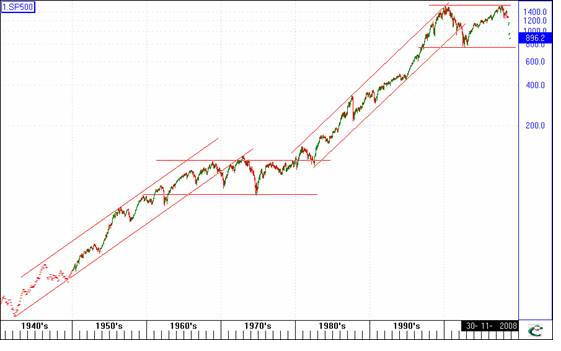

The ‘buy and hold’ strategy employed by many equity investors over recent years during the bull market has proved disastrous as the market has collapsed. They have been left holding stocks that have collapsed in price, as the underlying businesses have imploded. With no clearly defined exit strategy or portfolio exposure minimisation strategy, they have simply sat and watched as their capital has eroded in line with downward pressure on share prices. Many of these investors are down in excess of 50%.
I know of one so called ‘buy and hold’ investor with a significant parcel of RIO shares in his portfolio. The price of RIO has collapsed from a high of just short of $160.00 per share in May of this year, to around $40.00 today – and, he still has them in his portfolio!
He has not only suffered a huge reduction in the value of his portfolio, but has foregone a huge profit on the ‘trade’ through not having a clearly defined exit strategy in place. A compounding investment error is having too much of his portfolio in a single stock; we call this a money management error. In addition, the opportunity cost of not having banked the profit or limited the loss is enormous. Just think of what he could do with all the lost profit from that trade when the market once again presents us with buy signals! Instead, he is locked into a dud position with his fingers crossed while he waits for the market to return to the levels we saw in late 2007/early 2008.
Needless to say, he was NOT a OmniTrader user. If he had been, he would have had clear and unambiguous sell signals provided by the system, and would have been able to exit the trade, bank the profit or limit losses, and participate in new buy signals as and when they present themselves, starting again from a far higher capital base.
This is just a single stock without leverage through, say, a margin lending facility! Bring leverage into the equation across a number of stocks and the picture is far worse.
The majority of people in these and similar positions have little or no plan for engaging the market. Their buying decisions are loosely based on fundamental analysis, news stories, broker ‘advice’, newsletters, or hot tips from a mate, and do OK during a rampaging bull market, such as the one we experienced up until the end of 2007. But when the bull market ends and the bears gain control, these “punters” have no defined point at which to exit or lighten their positions.
Many also engage in another silly activity – that of averaging down! Instead of cutting their losses they fall for the age old trap of buying more because the price is now cheap. If the stock was a good deal at $10.00 per share, it must be an even better deal at $5.00, and then again at $2.00. They then watch as the market smashes their beloved share even further and they are left holding a worthless stock as a long term investment. The outcome of averaging down is increasing your exposure in a stock that is trending down! You should only do the exact opposite! Averaging down is predicated on the myth that all stocks will eventually go up again. Firstly, this is a total unknown and mostly untrue and secondly, if they ever do, when?
Put simply, buy and hold strategies, don’t work over the long term. All it needs is a market reset such as has occurred with too much exposure to the wrong stocks or too much leverage - at the wrong time of your investing career - and your portfolio may never recover. Many have said it is “time in the market”. I have always disagreed. It is “time in the market” and “timing the market”.

The monthly log chart of the S&P500 (US) shows a 20 year bull market followed by a 17 year sideways market then followed by a 17 year bull market. The S&P500 has been moving sideways now for nearly 9 years. Both sideways markets have had 50% or near 50% bear markets and 60%+ bull markets during the long term secular sideways movement. It may be many years before equity market indices make new highs that lend themselves to the buy and hold strategy again, as buy and hold strategies ONLY work in secular bull markets such as those from the mid 1940’s to the mid 1960’s and the late 1982 to early 2000 bull market.
Active investment strategies will work in both long term secular bull markets and long term secular bear markets that mostly go sideways over many years. Why take the chance with a buy and hold strategy? Can your portfolio afford to move sideways with the market for many years to come if the sideways market continues for another 8 – 10 years?
Actively managed portfolio’s with a clear strategy for undertaking ALL buy and sell decisions that has an edge will always outperform the overall market and the buy and hold investor provided that the actively managed portfolio is sufficiently capitalised..
Mechanical traders and investors know that their system has a clearly defined and measurably EDGE in the market, combined with a strict set of trading rules and processes for engaging the market with confidence and consistency. They also employ strict money management and risk management that they adhere to at all times. In essence they know what to do, when to do it, and how much of it to do. They have minimal emotional involvement with their trades (unlike our friend above with the RIO shares) - they have developed a portfolio mindset, make minimal trading errors and they have developed the ability to execute all trades with a Traders Mindset .
I mentioned brokerage above. Active investment strategies in equities were impossible to deploy up until the mid 1990's because the minimum brokerage rates were too high to actively trade. Stock prices, on average, did and do not move enough over a 2 - 4 month period to cover 2.5% each way brokerage rates. With minimum brokerage rates below $20 or 0.11% the era of actively managing portfolios was born. Couple this with the availability of investing tools and the 52% retracement of equity markets in 2008 the buy and hold investment strategy may go the way of the dinosaurs.
What will the market do in 2009? Who knows! The most important question is – “Will you be ready to participate when it does turn and the next uptrend begins?” Will you be prepared and confident and not only know what to do but to do what you know? Or will you still knee-jerk react by randomly selecting stocks based on news stories, fundamental analysis, brokers advice, newsletters, or some un-researched set of technical indicators? The key to success is to learn from the mistakes of the past, educate yourself, be prepared, and know exactly what to do next time.
Employ a proven, mechanical trading system like OmniTrader, and begin trading and investing in a professional manner using a proven strategy and processes with a clearly defined and measurable edge in the market. Doing the same thing that you have always done will result in the same outcomes.
Learn more about OmniTrader's development
What do we mean by Trade the Moves
What is the difference between Technical and fundamental analysis
